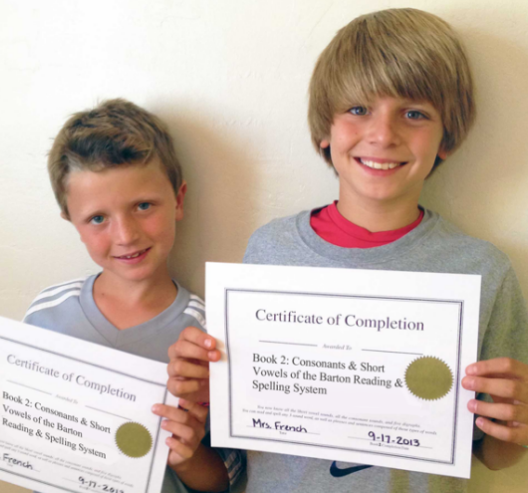Choosing a tutoring program that works for your child

Many or most programs claim they are research-based, but the words “research-based” in a brochure or on a label, cannot be relied on to indicate that a program is truly research based. Even among programs that are aligned with the findings of scientifically based reading research, significant differences exist as to how well different programs can meet the needs of at-risk readers. The inclusion of research-aligned exercises will not by itself make a program effective.
The construction of the entire program and whether or not it is used as designed (with fidelity) will determine its effectiveness.
We choose to implement only curriculums for which there is evidence of effectiveness, and we use these programs with fidelity, meaning that we use them under the recommended conditions in which they were proven to work well. In order to maintain the systematic nature of the curriculum, we do not pick and choose pieces of programs, nor do we mix parts of different programs together.
We DO individualize your child’s program as one might slightly adjust the proportions of ingredients in a proven cookie recipe, a little less or more flour, but never leaving the flour out altogether. The nature and severity of the underlying cause of a student’s reading difficulty, as well as his response to the instruction he is receiving, determines the optimal “recipe” for each student. For example, the proportion of instructional ingredients used for a student who reads rapidly but inaccurately, would likely need to be adjusted for a student who reads accurately but slowly. The diagnostic nature of the instruction, along with continuous monitoring of your child’s progress, allows us to “tweak” the program for each student in order to maximize his/her rate of improvement.
The Barton System of Reading and Spelling
After we assess your child and determine his learning profile, we will recommend an appropriate intervention program. The Barton Reading and Spelling Program, an adaptation of the Orton-Gillingham method and science of reading aligned, is one of our primary programs.
Susan Barton, the developer of the Barton Reading and Spelling System, trained in seven different Orton-Gillingham systems before she developed her own program, integrating the best features of each. The Barton program is the only program that specifically addresses phonemic awareness in its first level, and continues to incorporate phonemic awareness into the next three levels of the program as well. This is critical because the lack of sufficient phonemic awareness has been proven to be the most common reason that children may not read up to their intellectual potential. A science of reading aligned Orton-Gillingham program directly develops phonemic awareness, and then goes on to teach systematic phonics for reading and writing.
Orton-Gillingham methodology is different from traditional reading programs in how it teaches:
1. It is a multisensory approach, which means that it simultaneously integrates visual, auditory, kinesthetic and tactile activities. Research shows that people who experience reading difficulty learn best by involving all of their senses.
2. It is explicit. Explicit or direct teaching means there is no guesswork required on the part of the student. The tutor explains exactly what the student is to learn.
3. It is systematic, meaning that skills are taught according to the level of difficulty, from easiest to hardest; rules are introduced in order from most to least common; and each step is based on learning the previous steps. In this way, a strong foundation is built.
4. Each lesson is diagnostic in the sense that the tutor continuously monitors the verbal, non-verbal, and written responses of the student in order to identify and analyze the student’s progress to determine when mastery has occurred and the student is able to successfully advance to the next step.
5. Each lesson is prescriptive in that it is individualized around the student’s needs. The Orton-Gillingham motto is: “Go as fast as you can but as slow as you need to.”
6. It is cumulative, meaning that all previous learning is reinforced and embedded in every lesson.
Orton-Gillingham methodology is also different from traditional reading programs in what it teaches:
1. Phonology and phonological awareness is taught throughout the program. Phonology is the study of sounds and how they work within their environment. Students master the blending of sounds and letters into words, as well as the segmenting of whole words into their individual sounds.
2. Sound-symbol associations are directly developed. The sounds in spoken language correspond to letters and combinations of letters. These letter-sound correspondences are mastered in two directions: visual to auditory and auditory to visual.
3. Six basic types of syllables are taught to facilitate the reading of longer multi-syllable words. Identifying syllable types allows students to accurately predict the sound the vowel will make.
4. Morphology is a critical aspect of reading instruction because our language is both sound and meaning based. Morphology relates to meaningful chunks of language, such as base words, roots, and affixes. It is taught after foundational decoding skills are established.
5. Syntax refers to the rules that govern word order and sentence meaning. This includes grammar, sentence variation and the mechanics of language.
6. Semantics is another component of Orton-Gillingham instruction. Simply put, semantics refers to the understanding of what words mean in order to enable comprehension. This would include vocabulary development, antonyms and synonyms, multiple meanings, homonyms, etc.
A Note about Writing and Vocabulary Instruction
Students enrolled in the Barton System of Reading benefit from direct and explicit vocabulary instruction. At Foundations Tutoring, we utilize visualizing techniques to teach new vocabulary because we know that our students are strong visual learners. We are careful to relate new word meanings to prior knowledge and experience, as well as provide practice in using new words in various ways and contexts. The words are systematically reviewed until they become part of the child’s permanent memory and working vocabulary.
Writing delays may be related to difficulties with handwriting, spelling, mechanics, attention and impulsivity, as well as limited vocabulary and expressive language. The nature of effective writing instruction is dependent on the underlying cause of the student’s writing difficulty.
